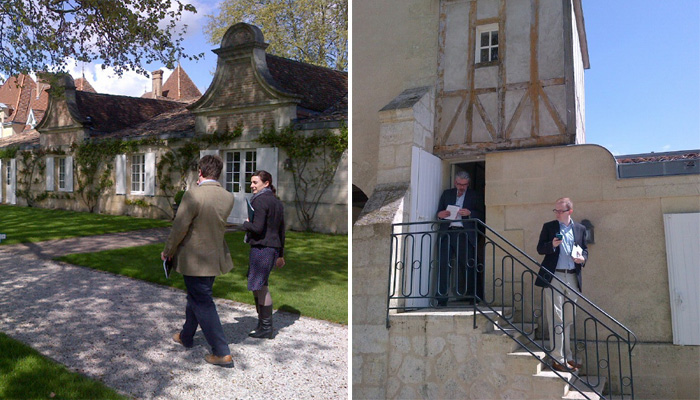Lunch at Rauzan Segla
Author: Guest Blogger
 Wednesday 11th April brought Berrys’ Fine Wine team to Rauzan Segla. Rated as a second Growth in the 1855 classification and listed in 6th place just after Ch. Mouton Rothschild, this property sits on some terrific terroir. Having changed hands a number of times during its history, the building and its wines fell into disrepair and lost much of their status. Rescue came in the form of the Wertheimer brothers’ Chanel group who bought the property in 1994. They have installed John Kolasa, formerly of Latour, as general manager and his aim (with Chanel’s financial backing) is to bring the wine back to its proper glory, making use of its fabulous terroir to see this wine list among the ‘super-seconds’.
Wednesday 11th April brought Berrys’ Fine Wine team to Rauzan Segla. Rated as a second Growth in the 1855 classification and listed in 6th place just after Ch. Mouton Rothschild, this property sits on some terrific terroir. Having changed hands a number of times during its history, the building and its wines fell into disrepair and lost much of their status. Rescue came in the form of the Wertheimer brothers’ Chanel group who bought the property in 1994. They have installed John Kolasa, formerly of Latour, as general manager and his aim (with Chanel’s financial backing) is to bring the wine back to its proper glory, making use of its fabulous terroir to see this wine list among the ‘super-seconds’.
Today the property reflects the Chanel elegance and a lunch invite by John Kolasa provided a welcome break in our busy schedule. We started our visit with a tasting in the small tower. The tasting started with 2008, 2006 and 2005 Segla. This second wine is generally not released en primeur, but only appears on the market with a few years of bottle age so it can be drunk straight from the shelf. A reliable choice that should be a good option if you see it on a restaurant wine list.
With a challenging vintage such as 2011, I was surprised to see that they were showing us 2009 and 2010 alongside the 2011 sample. Overall the line up was impressive and shows that quality has been improving dramatically over the past few years and that it deserves its Second Growth rating among the top of Margaux’s classification. The 2010 was glossy, polished with silky tannins and beautiful aromas; the 2009, as expected, denser with a superb length. We were also shown the surprise label of the 2009 vintage designed by Karl Lagerfeld to celebrate the 350th anniversary of the estate in addition to the set of anti-counterfeiting measures. The 2011 stood up well alongside the 2009 and 2010, with dark black fruit and typical Margaux perfume of spring flowers. 3.5% of Petit Verdot has been added to the blend as a nod towards the property’s history when it used to be routinely included.
After the tasting, we joined John in the beautifully decorated reception room with a glass of 1995 Pol Roger. Rich, mature, at its peak we had a fascinating discussion about the forthcoming en primeur. John is convinced that we will see a release of a First Growth next week, heralding the beginning of a potentially busy en primeur season. We had a relaxed discussion about pricing. With a vintage that is better for some producers in 2011 than we initially expected, but lacks the glory of the 2009-2010, pricing is going to be key. With a few exceptions, these are wines to be enjoyed in 5-15 years and will need to be priced as such. 2011 in the main will need to be consumed before the 2009, 2010 or even 2005. We were positively surprised to see that John agreed and argued that with high release prices for the 2009 and 2010, Bordeaux needs to remember its faithful drinking customer.
Lunch was served in the cozy but attractive dining room. The building breathes understated Chanel elegance and it is hard to imagine that a decade ago this building was not much more than a ruin. The redecorations are completely based on original designs and it feels as if nothing has changed over the past century. With a delicious white fish and asparagus starter we were served 2005 Chantegrive Cuvée Caroline. A wine I have not tried before and absolutely delicious with notes of honeysuckle and smoke that make aged white Bordeaux so attractive.
Over lunch John explained some of the changes he has brought to the estate, including how they had focused on replanting the vineyards at much higher density and with an increasing percentage of Merlot. John also installed a 5 meter sorting table, which is highly valuable in a vintage such as 2011.
Over the main course John indulged us with 1989 and 1999 Rauzan Segla. Next to each other the 1999 was obviously youthful, but the 1989 was a surprising treat. John personally prefers the 1989 to the better rated 1990 and it is not difficult to see why. It was a harmonious mature claret with typical Margaux elegance with sweet richness and bright fruit, that lifted the spirit and conversation. If you can find a bottle, I would highly recommend doing so. John’s passion for producing quality wine both at Rauzan Segla and at his own property Canon was in clear evidence as he described how he organizes blind tastings of Parker rated verticals and First Growths alike.
Leaving this beautiful property and the amiable John Kolasa was not easy as we continued our tastings. I am just hoping that this year, Rauzan Segla manages to get its pricing strategy better than last year. If so, then 2011 may make a perfect addition for the cellar.
Sara Guiducci


